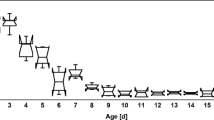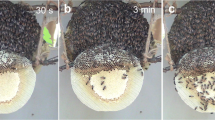Summary
Honeybee nurses (8 days old) were injected with 14C-phenylalanine. These bees then dispensed the 14C-labelled protein-rich products of their hypopharyngeal glands to the queen and the brood, and also to young drones and workers of all age classes. In small colonies containing 400–800 bees, nearly one-quarter of the radioactivity which could not be recovered in the nurses was fed by them in a protein-bound form to other members of the worker caste. During one night, one nurse fed an average of 4–5 foragers with proteinaceous food. The role of nurses in the work allotment system of honeybee colonies therefore needs a new, extended definition. Nurses are largely responsible for preparing nutrients from pollen, which is difficult to digest. They then distribute the nutritionally valuable protein produced by their hypopharyngeal glands to practically all hive mates.
Similar content being viewed by others
References
Brouwers EVM (1982) Measurement of hypopharyngeal gland activity in the honeybee. J Apicult Res 21:193–198
Crailsheim K (1986) Depenence of protein metabolism on age and season in the honeybee (Apis mellifica carnica Pollm). J Insect Physiol 32:629–634
Crailsheim K (1988a) Transport of leucine in the alimentary canal of the honeybee (Apis mellifera L.) and its dependence on season. J Insect Physiol 34:1093–1100
Crailsheim K (1988b) Regulation of food passage in the intestine of the honeybee (Apis mellifera L.). J Insect Physiol 34:85–90
Crailsheim K (1990) Protein synthesis in the honeybee (Apis mellifera L.) and trophallactic distribution of jelly among imagos in laboratory experiments. Zool Jahrb 94:302–312
Crailsheim K, Stolberg E (1989) Influence of diet, age, and colony condition upon intestinal proteolytic activity and size of the hypopharyngeal glands in the honeybee (Apis mellifera L.). J Insect Physiol 35:595–602
Fluri P, Lüscher M, Wille H, Gering L (1982) Changes in weight of the pharyngeal gland and haemolymph titres of juvenile hormone, protein, and vitellogenin in worker honey bees. J Insect Physiol 28:61–68
Frisch K von (1965) Tranzsprache und Orientierung der Bienen. Springer, Berlin Heidelberg New York
Free JB (1957a) The food of adult drone honeybees (Apis mellifera). Br J anim Behav 5:7–11
Free JB (1957b) The transmission of food between worker honeybees. Br J anim Behav 5:41–47
Free JB (1965) The allocation of duties among worker honeybees. Symposion Zool Soc London 14:39–59
Frumhoff PC, Baker J (1988) A genetic component to division of labour within honeybee colonies. Nature 333:358–361
Grogan DE, Hunt JH (1980) Age-correlated changes in midgut protease activity of the honeybee. Apis mellifera (Hymenoptera: Apidae). Experientia 36:1347–1348
Haydak MH (1934) Changes in total nitrogen content during the life of the imago of the worker honeybee. J Agr Res 49:21–28
Haszonits O, Crailsheim K (1990) Uptake of L-leucine into isolated enterocytes of the honeybee (Apis mellifera L.) depending on season. J Insect Physiol 36:835–842
Heran H, Crailsheim K (1988) Energy requirements in bees (Apis mellifera carnica Pollm.) in free flight, with and without additional load. Veröffentlichungen der Universität Innsbruck 167:77
Hillesheim E, Koeniger N, Moritz RFA (1989) Colony performance in honeybees (Apis mellifera capensis Esch.) depends on the proportion of subordinate and dominant workers. Behav Ecol Sociobiol 24:291–296
Huang Z-Y, Otis GW (1989) Factors determining hypopharyngeal gland activity of worker honey bees (Apis mellifera L.). Insect Soc 36:264–276
Jimenez DR, Gilliam M (1989) Age-related changes in midgut ultrastructure and trypsin activity in the honeybee. Apis mellifera. Apidologie 20:287–303
Kiechle H (1961) Die soziale Regulation der Wassersammeltätigkeit im Bienenstaat und deren physiologische Grundlage. Z Vergl Physiol 45:154–192
Kolmes SA, Winston ML, Fergusson LA (1989) The division of labor among worker honeybees (Hymenoptera: Apidae): The effect of multiple patrilines. J Kansas Entomol Soc 62:80–95
Kunert K, Crailsheim K (1987) Sugar and protein in the food for honeybee worker larvae. In: Eder J, Rembold H (eds) Chemistry and biology of social insects. J. Peperny, München, pp 164–165
Lindauer M (1954) Ein Beitrag zur Frage der Arbeitsteilung im Bienenstaat. Z Vergl Physiol 34:299–345
Lindauer M (1954) Temperaturregulierung und Wasserhaushalt im Bienenstaat. Z Vergl Physiol 36:391–432
Lotmar R (1938) Untersuchungen über den Eisenstoffwechsel der Insekten, besonders der Honigbiene. Rev Suisse Zool 45:237–271
Maurizio A (1954) Pollenernährung und Lebensvorgänge bei der Honigbiene (Apis mellifera L.). Landw Jrb Schweiz 62:115–182
Michener CD (1974) The social behavior of the bees. The Belnkamp Press of Harvard University Press. Cambridge Massachusetts
Mindt B (1962) Untersuchungen über das Leben der Drohnen. insbesondere Ernährung und Geschlechtsreife. Z Bienenforschung 6:9–33
Moritz B, Crailsheim K (1987) Physiology of protein digestion in the midgut of the honeybee (Apis mellifera L.). J Insect Physiol 33:923–931
Neukirch A (1982) Dependence of the life span of the honeybee (Apis mellifera) upon flight performance and energy consumption. J Comp Physiol B 146:35–40
Nixon HL, Ribbands CR (1952) Food transmission within the honeybee community. Proc Roy Soc B 140:43–50
Rembold H (1974) Die Kastenbildung bei der Honigbiene, Apis mellifera L., aus biochemischer Sicht. In: Schmidt GH (ed) Sozialpolymorphismus bei Insekten. Wissenschaftliche Verlagsgesellschaft, Stuttgart, pp 350–403
Robinson GE, Page RE Jr (1988) Genetic determination of guarding and undertaking in honeybee colonies. Nature 333:356–358
Robinson GE, Page RE Jr (1989) Genetic determination of nectar foraging, pollen foraging, and nest-site scouting in honeybee colonies. Behav Ecol Sociobiol 24 (5):317–323
Robinson GE, Page RE Jr, Strambi C, Strambi A (1989) Hormonal and genetic control of behavioral integration in honeybee colonies. Science 246:109–112
Rösch GA (1925) Untersuchungen über die Arbeitsteilung im Bienenstaat, I. Teil: Die Tätigkeiten im normalen Bienenstaate und ihre Beziehungen zum Alter der Arbeitsbienen. Z Vergl Physiol 2:571–631
Rösch GA (1930) Untersuchungen über die Arbeitsteilung im Bienenstaat, II. Teil: Die Tätigkeiten der Arbeitsbienen unter experimentell veränderten Bedingungen. Z Vergl Physiol 12:1–71
Sachs L (1972) Statistische Auswertungsmethoden, 3. Aufl. Springer, Berlin Heidelberg New York
Sasagawa H, Sasaki M, Okada I (1989) Hormonal control of the division of labor in adult honeybees (Apis mellifera L.) I. Effect of methophrene on corpora allata and hypopharyngeal gland, and its α-glucosidase activity. Appl Ent Zool 24:66–77
Seeley TD (1982) Adaptive significance of the age polyethism schedule in honeybee colonies. Behav Ecol Sociobiol 11:287–293
Takenaka T, Kaatz HH (1987) Protein synthesis by hypopharyngeal glands of worker honeybees. In: Eder J, Rembold H (eds) Chemistry and biology of social insects. J Peperny, München, pp 166–167
Author information
Authors and Affiliations
Additional information
Dedicated to Professor Dr. O. Kepka on the occasion of his 65th birthday
Rights and permissions
About this article
Cite this article
Crailsheim, K. Interadult feeding of jelly in honeybee (Apis mellifera L.) colonies. J Comp Physiol B 161, 55–60 (1991). https://doi.org/10.1007/BF00258746
Accepted:
Issue Date:
DOI: https://doi.org/10.1007/BF00258746




